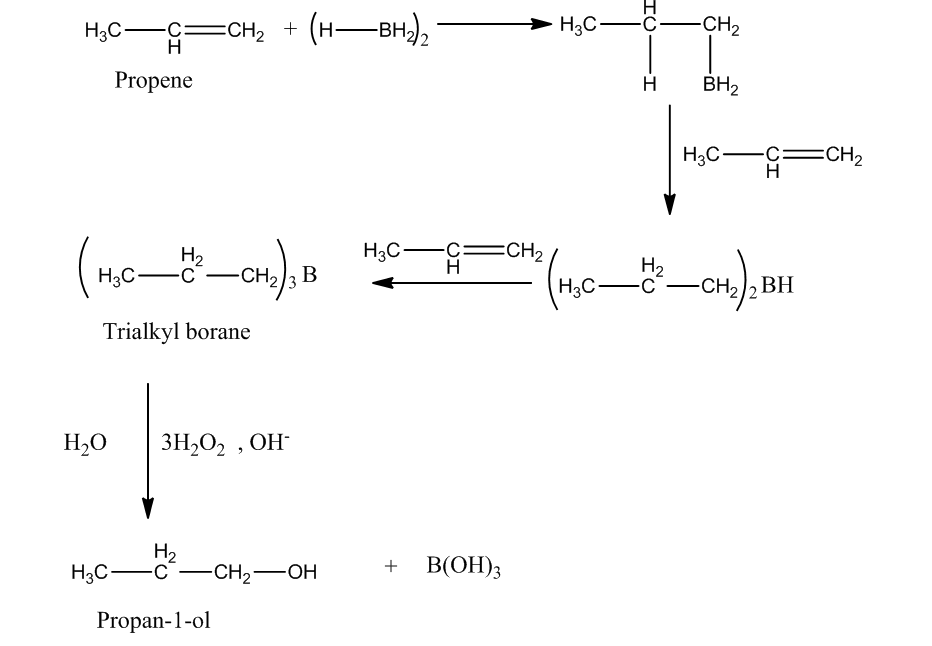
How will you convert:
(i) Propene to propan-1-ol
(ii) Ethanal to propan-2-ol
Answer
504.5k+ views
Hint: - (i )In conversion of propene to propan-1-ol, oxidation reaction takes place. Oxidation reaction is the reaction in which oxygen is added to a compound. To convert propene to propan-1-ol, we will use the method of reaction of propene with peroxide.
Complete step-by-step answer:
Reaction of alkene with hydrogen halide in presence of peroxide results Anti Markovnikov’s addition. Anti Markovnikov’s addition states that in reaction of alkene with hydrogen halide, hydrogen is added to the carbon atom of the double bond which is bonded to least number of hydrogen atoms and the halide atom is boned to the another carbon atom of double bond.

The produced alkyl halide reacts with KOH followed by heating produces propan-1-ol.

Note:
The other method to produce propan-1-ol from propene is hydroboration oxidation reaction. In this reaction, reaction of diborane $\left( {{\rm{B}}{{\rm{H}}_{\rm{3}}}} \right)$with propene produces trialkyl boranes (addition product). Then, the oxidation trialkyl boranes to alcohol takes place by ${{\rm{H}}_{\rm{2}}}{{\rm{O}}_{\rm{2}}}$(peroxide) in presence of a base $\left( {{\rm{NaOH}}} \right)$.

(ii)
Hint:
In conversion of ethanal to propan-2-ol, the carbon atom increases by one. So, we will use Grignard reagent so, that, parent chain can be increased by one carbon atom.
Complete step-by-step answer:
The reaction of Grignard reagent with carbonyl compounds produces alcohol. We need one more carbon atom than the original reactant. So, we have to use ${\rm{C}}{{\rm{H}}_{\rm{3}}}{\rm{MgI}}$ as the Grignard reagent.
Step 1: The nucleophilic attack of Grignard reagent to the carbonyl group produces an adduct.

Step2: Hydrolysis of adduct produces an alcohol.

Note: It is possible to get confused in taking Grignard reagent for the conversion of ethanal to propan-2-ol. You have to observe the number of carbon atoms in reactant and the product. In the given question, one more carbon atom is present in product than the reactant. So, Grignard reagent has only one carbon atom.
Complete step-by-step answer:
Reaction of alkene with hydrogen halide in presence of peroxide results Anti Markovnikov’s addition. Anti Markovnikov’s addition states that in reaction of alkene with hydrogen halide, hydrogen is added to the carbon atom of the double bond which is bonded to least number of hydrogen atoms and the halide atom is boned to the another carbon atom of double bond.

The produced alkyl halide reacts with KOH followed by heating produces propan-1-ol.

Note:
The other method to produce propan-1-ol from propene is hydroboration oxidation reaction. In this reaction, reaction of diborane $\left( {{\rm{B}}{{\rm{H}}_{\rm{3}}}} \right)$with propene produces trialkyl boranes (addition product). Then, the oxidation trialkyl boranes to alcohol takes place by ${{\rm{H}}_{\rm{2}}}{{\rm{O}}_{\rm{2}}}$(peroxide) in presence of a base $\left( {{\rm{NaOH}}} \right)$.

(ii)
Hint:
In conversion of ethanal to propan-2-ol, the carbon atom increases by one. So, we will use Grignard reagent so, that, parent chain can be increased by one carbon atom.
Complete step-by-step answer:
The reaction of Grignard reagent with carbonyl compounds produces alcohol. We need one more carbon atom than the original reactant. So, we have to use ${\rm{C}}{{\rm{H}}_{\rm{3}}}{\rm{MgI}}$ as the Grignard reagent.
Step 1: The nucleophilic attack of Grignard reagent to the carbonyl group produces an adduct.

Step2: Hydrolysis of adduct produces an alcohol.

Note: It is possible to get confused in taking Grignard reagent for the conversion of ethanal to propan-2-ol. You have to observe the number of carbon atoms in reactant and the product. In the given question, one more carbon atom is present in product than the reactant. So, Grignard reagent has only one carbon atom.
Recently Updated Pages
Difference Between Alcohol and Phenol: Structure, Tests & Uses

Classification of Drugs in Chemistry: Types, Examples & Exam Guide

JEE Atomic Structure and Chemical Bonding important Concepts and Tips

JEE Amino Acids and Peptides Important Concepts and Tips for Exam Preparation

Electricity and Magnetism Explained: Key Concepts & Applications

Chemical Properties of Hydrogen - Important Concepts for JEE Exam Preparation

Trending doubts
JEE Main 2026: Application Form Open, Exam Dates, Syllabus, Eligibility & Question Papers

Derivation of Equation of Trajectory Explained for Students

Hybridisation in Chemistry – Concept, Types & Applications

Understanding the Angle of Deviation in a Prism

Understanding Collisions: Types and Examples for Students

How to Convert a Galvanometer into an Ammeter or Voltmeter

Other Pages
NCERT Solutions For Class 12 Chemistry Chapter 1 Solutions - 2025-26

NCERT Solutions for Class 12 Chemistry Chapter Chapter 7 Alcohol Phenol and Ether

NCERT Solutions ForClass 12 Chemistry Chapter Chapter 8 Aldehydes Ketones And Carboxylic Acids

JEE Advanced Marks vs Ranks 2025: Understanding Category-wise Qualifying Marks and Previous Year Cut-offs

Haloalkanes and Haloarenes Class 12 Chemistry Chapter 6 CBSE Notes - 2025-26

Solutions Class 12 Chemistry Chapter 1 CBSE Notes - 2025-26




